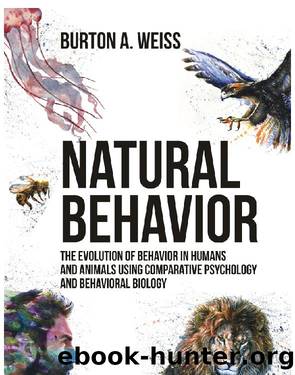Natural Behavior by Weiss Burton A.;

Author:Weiss, Burton A.;
Language: eng
Format: epub
Publisher: Universal Publishers
Arthropoda
Arthropod means âjointed foot.â They are the most numerous of species with as many as 900,000 species or three quarters of all species. The arthropods are ubiquitous throughout the world, except they do not function well below 7.2 °C (45 °F) and therefore, are dormant in winter and absent in arctic climates. Their body consists of an external cuticle, composed of protein and chitin. Essentially, they live in a tubular exoskeleton. Joints in the tube allow flexibility for movement. But the exoskeleton does not expand for growth. Thus, molting is required to enlarge the body. Arthropods are the most numerous in individuals of any phylum, and are more populous than all other phyla combined. There are six major living classes and two extinct, all of which will be briefly reviewed, because the study of any one of them can occupy an entire career. The classes are organized into the subphyla: Trilobites, Chelicerata, and Mandibulata.
Trilobites are all extinct. They were organized with multiple similar segments and represent the ancestors of the modern Arthropods.
Chelicerata, means pincer-like or fang-like mouth parts, and includes the class Eurypterida of extinct sea scorpions, the class Xiphosura or horseshoe crabs, which are not crabs, the class Arachnida, which are the spiders, ticks, mites, scorpions, and relatives, all having eight legs, and the class Pychnogonida or sea spiders. Of the Chelicerata, the spiders are the most well known. All spiders have poisonous venom, although, because of the diseases they carry, ticks are the most dangerous of the Arachnida to humans.
Spiders are all poisonous predators and all are capable of spinning silk fibers from their abdomens. Some are hunters and also ambush prey, mostly insects. The early use of the fiber was as a trail marker to guide the return to the nest. After many journeys, the accumulating fibers probably trapped prey and lead to the evolution of the use of the fibers as a web to catch prey. The web design is species specific and has been employed to examine the effect of drugs on the nervous system by causing alterations in the structure of the web. Spiders can travel by letting out strands in the air currents to attach to another branch and serve as a bridge. People can encounter the web strands while walking outside in the morning. Spiders can also let out strands to function as a parachute when they drop to the ground. Spiders can jump into water and absorb air from bubbles stuck in their body hair. Usually, spiders are solitary and mate by the male tying down the dangerous female. In some species of spiders, the female will tend the young. The water spider (Argyroneta aquatica) uses web to tie together underwater plants and fill the dome with captured air for a lair, the brood, and the young hatchlings.
Mandibulata have antennae and mandibles and include the following four classes. Diplopoda, which are the millipedes. Millipedes are vegetarian consumers of plants and have four legs per segment. Chilopoda, are the centipedes. Centipedes are all poisonous predators and have two legs per segment.
Download
This site does not store any files on its server. We only index and link to content provided by other sites. Please contact the content providers to delete copyright contents if any and email us, we'll remove relevant links or contents immediately.
Spare by Prince Harry The Duke of Sussex(4791)
Machine Learning at Scale with H2O by Gregory Keys | David Whiting(3640)
Fairy Tale by Stephen King(2952)
Will by Will Smith(2581)
Hooked: A Dark, Contemporary Romance (Never After Series) by Emily McIntire(2423)
The Bullet Journal Method by Ryder Carroll(2401)
Rationality by Steven Pinker(2150)
It Starts With Us (It Ends with Us #2) by Colleen Hoover(2044)
Can't Hurt Me: Master Your Mind and Defy the Odds - Clean Edition by David Goggins(2004)
Friends, Lovers, and the Big Terrible Thing by Matthew Perry(1998)
The Becoming by Nora Roberts(1920)
Love on the Brain by Ali Hazelwood(1818)
HBR's 10 Must Reads 2022 by Harvard Business Review(1698)
The Strength In Our Scars by Bianca Sparacino(1695)
A Short History of War by Jeremy Black(1671)
Leviathan Falls (The Expanse Book 9) by James S. A. Corey(1522)
515945210 by Unknown(1521)
Bewilderment by Richard Powers(1448)
443319537 by Unknown(1395)
